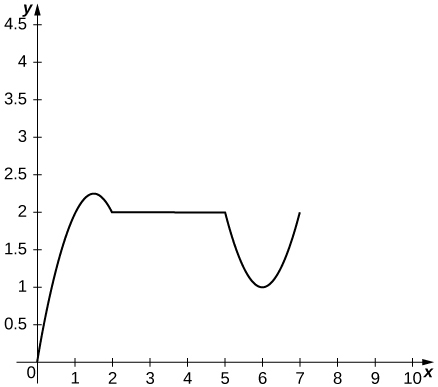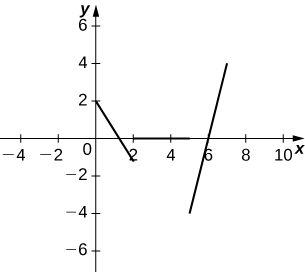3.6 E: Rates of Change Exercises
( \newcommand{\kernel}{\mathrm{null}\,}\)
3.6: Derivatives as Rates of Change
Exercise:
144) A car driving along a freeway with traffic has traveled
a. Determine the time in seconds when the velocity of the car is 0.
b. Determine the acceleration of the car when the velocity is 0.
145) A herring swimming along a straight line has traveled
seconds. Determine the velocity of the herring when it has traveled 3 seconds.
Solution:
146) The population in millions of arctic flounder in the Atlantic Ocean is modeled by the function
a. Determine the initial flounder population.
b. Determine
147) [T] The concentration of antibiotic in the bloodstream
a. Find the rate of change of
b. Determine the rate of change for
c. Briefly describe what seems to be occurring as the number of hours increases.
Solution:
148) A book publisher has a cost function given by
For the following exercises, the given functions represent the position of a particle traveling along a horizontal line.
a. Find the velocity and acceleration functions.
b. Determine the time intervals when the object is slowing down or speeding up.
150)
151)
Solution: a.
152)
153) A rocket is fired vertically upward from the ground. The distance s in feet that the rocket travels from the ground after t seconds is given by
a. Find the velocity of the rocket 3 seconds after being fired.
b. Find the acceleration of the rocket 3 seconds after being fired.
Solution:
154) A ball is thrown downward with a speed of 8 ft/s from the top of a 64-foot-tall building. After t seconds, its height above the ground is given by
a. Determine how long it takes for the ball to hit the ground.
b. Determine the velocity of the ball when it hits the ground.
155) The position function
a. Determine the velocity of the car when
b. Determine the velocity of the car when
Solution:
156) The position of a hummingbird flying along a straight line in t seconds is given by
a. Determine the velocity of the bird at
b. Determine the acceleration of the bird at
c. Determine the acceleration of the bird when the velocity equals 0.
157) A potato is launched vertically upward with an initial velocity of 100 ft/s from a potato gun at the top of an 85-foot-tall building. The distance in feet that the potato travels from the ground after
a. Find the velocity of the potato after
b. Find the speed of the potato at 0.5 s and 5.75 s.
c. Determine when the potato reaches its maximum height.
d. Find the acceleration of the potato at 0.5 s and 1.5 s.
e. Determine how long the potato is in the air.
f. Determine the velocity of the potato upon hitting the ground.
Solution: a. 84 ft/s, −84 ft/s b. 84 ft/s c.
158) The position function
a. Determine the direction the train is traveling when
b. Determine the direction the train is traveling when
c. Determine the time intervals when the train is slowing down or speeding up.
159) The following graph shows the position

a. Use the graph of the position function to determine the time intervals when the velocity is positive, negative, or zero.
b. Sketch the graph of the velocity function.
c. Use the graph of the velocity function to determine the time intervals when the acceleration is positive, negative, or zero.
d. Determine the time intervals when the object is speeding up or slowing down.
Solution: a. Velocity is positive on
b.
c. Acceleration is positive on
160) The cost function, in dollars, of a company that manufactures food processors is given by
a. Find the marginal cost function.
b. Find the marginal cost of manufacturing 12 food processors.
c. Find the actual cost of manufacturing the thirteenth food processor.
161) The price p (in dollars) and the demand x for a certain digital clock radio is given by the price–demand function
a. Find the revenue function
b. Find the marginal revenue function.
c. Find the marginal revenue at
Solution: a.
162) [T] A profit is earned when revenue exceeds cost. Suppose the profit function for a skateboard manufacturer is given by
a. Find the exact profit from the sale of the thirtieth skateboard.
b. Find the marginal profit function and use it to estimate the profit from the sale of the thirtieth skateboard.
163) [T] In general, the profit function is the difference between the revenue and cost functions:
Suppose the price-demand and cost functions for the production of cordless drills is given respectively by
a. Find the marginal cost function.
b. Find the revenue and marginal revenue functions.
c. Find
d. Find the profit and marginal profit functions.
e. Find
Solution: a.
164) A small town in Ohio commissioned an actuarial firm to conduct a study that modeled the rate of change of the town’s population. The study found that the town’s population (measured in thousands of people) can be modeled by the function
a. Find the rate of change function
b. Find
c. Find
165) [T] A culture of bacteria grows in number according to the function
a. Find the rate of change of the number of bacteria.
b. Find
c. Interpret the results in (b).
d. Find
Solution: a.
166) The centripetal force of an object of mass m is given by
a. Find the rate of change of centripetal force with respect to the distance from the center of rotation.
b. Find the rate of change of centripetal force of an object with mass 1000 kilograms, velocity of 13.89 m/s, and a distance from the center of rotation of 200 meters.
The following questions concern the population (in millions) of London by decade in the 19th century, which is listed in the following table.
| Year Since 1800 | Population (millions) |
| 1 | 0.8975 |
| 11 | 1.040 |
| 21 | 1.264 |
| 31 | 1.516 |
| 41 | 1.661 |
| 51 | 2.000 |
| 61 | 2.634 |
| 71 | 3.272 |
| 81 | 3.911 |
| 91 | 4.422 |
Population of LondonSource: http://en.wikipedia.org/wiki/Demographics_of_London
167) [T]
a. Using a calculator or a computer program, find the best-fit linear function to measure the population.
b. Find the derivative of the equation in a. and explain its physical meaning.
c. Find the second derivative of the equation and explain its physical meaning.
Solution: a.
168) [T]
a. Using a calculator or a computer program, find the best-fit quadratic curve through the data.
b. Find the derivative of the equation and explain its physical meaning.
c. Find the second derivative of the equation and explain its physical meaning.


